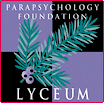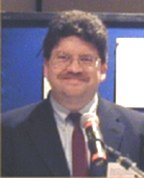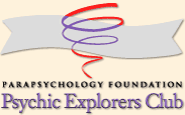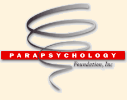 |
 |
| Carlos S. Alvarado, Ph.D.  It is difficult for me to explain the source of my interest in parapsychology. Around 1972 I developed an interest that I could not explain (I never had any personal experience with psychic phenomena). After reading about such varied topics as witchcraft and yoga, I encountered the psychical research tradition and immediately became attracted to its empirical and scientific approach. Late in 1972 I started studying the parapsychological literature. Not only did I read books by such well-known figures as J. B. Rhine, Louisa E. Rhine, J. G. Pratt, and René Sudre, but I started studying the papers published in the Journal of the American Society for Psychical Research, the Journal of Parapsychology, the Journal of the Society for Psychical Research, and the Parapsychology Review on all the aspects of parapsychology that they covered. This included methodological, historical, and conceptual papers, as well as spontaneous case research and experimental studies. Somewhat later, I started reading as well into the older literature. It is difficult for me to explain the source of my interest in parapsychology. Around 1972 I developed an interest that I could not explain (I never had any personal experience with psychic phenomena). After reading about such varied topics as witchcraft and yoga, I encountered the psychical research tradition and immediately became attracted to its empirical and scientific approach. Late in 1972 I started studying the parapsychological literature. Not only did I read books by such well-known figures as J. B. Rhine, Louisa E. Rhine, J. G. Pratt, and René Sudre, but I started studying the papers published in the Journal of the American Society for Psychical Research, the Journal of Parapsychology, the Journal of the Society for Psychical Research, and the Parapsychology Review on all the aspects of parapsychology that they covered. This included methodological, historical, and conceptual papers, as well as spontaneous case research and experimental studies. Somewhat later, I started reading as well into the older literature.
I remember deciding some time around 1972–1973 that I wanted to be a parapsychologist. Due to the lack of parapsychology educational programs, I decided that an education in psychology was the way to achieve my goals. This led me to get a BA in psychology in 1978 from the University of Puerto Rico. Later I was sent by the University of Puerto Rico (Mayagüez Campus) to obtain an MS degree in parapsychology because there were plans to expand an already existing research unit. I obtained the degree under the supervision of well-known parapsychologist Dr. John Palmer (John F. Kennedy University, 1981). (Unfortunately, administrative changes at the University in Puerto Rico led to the closing of the research unit and the abandonment of the plans to develop parapsychology there.) Further graduate degrees included one in history (MA, Duke University, 1989) and in psychology (PhD, University of Edinburgh, 1997). As for my work in parapsychology, I have been fortunate to have held the positions of Research Assistant to Dr. Ian Stevenson at the Division of Parapsychology (now the Division of Perceptual Studies of the University of Virginia, and Visiting Scholar at the Institute for Parapsychology (now the Rhine Research Center. Currently I am the Chair of Domestic and International Programs at the Parapsychology Foundation, where I work on editorial projects, public relations, the organization of conferences, and various educational activities. Furthermore, I currently work on my parapsychology research projects at the above mentioned Division of Perceptual Studies, affiliated to the University of Virginia’s Department of Psychiatric Medicine, where I am an Assistant Professor of Research in Psychiatric Medicine. Life has not been easy in terms of employment. I have spent periods of time in which I could barely find income-producing jobs, a situation I believe was due to a large extent to my very visible involvement with parapsychology. (When a person applies for a job in academe, it is customary to supply the prospective employer with a curriculum vitae, or “CV,” and my CV has a lot of parapsychology jobs, grants, and publications listed on it.) One aspect that has made my life easier is my marriage to Nancy L. Zingrone. A parapsychologist herself, Nancy and I are a collegial couple, by which I mean that we have worked together for many years (for examples of our work see the bibliography below). It is certainly easier to work in a difficult field if your spouse shares your interests and works with you in research projects, as Nancy and I have done. Overall, my life has been very exciting in a variety of ways. There are few disciplines more fascinating and engaging than parapsychology. For one, the phenomena studied have many implications for the understanding of the human mind and its interaction with the environment. As I have argued elsewhere, I believe that parapsychology has made several contributions to science (for a discussion click here). My own work in parapsychology has covered many areas and topics, but I will discuss only the main ones. I have many published papers presenting literature reviews the purpose of which is to acquaint parapsychologists and others with the rich and still relevant old (mainly pre-1930) literature of our field (see the bibliography below and click here. Unfortunately, much of this literature is forgotten even though it can be relevant to modern concerns. Some of my papers review the literature of particular phenomena such as ESP displacement effects and out-of-body experiences (OBEs), ESP and altered states of consciousness, and other issues such as the importance of the concepts of survival of death on the development of parapsychology, and the work of historical figures in the field, among them, Frederic W. H. Myers and Ernesto Bozzano. There are two areas in which I have worked primarily with my wife Nancy Zingrone. One of these is the study of OBEs. Our work on this phenomena has included comprehensive review papers, research into psychological correlates, and investigations of the relationship of OBE features to such variables as dreams, death-and non-death related circumstances, and other OBE features. Another of our areas of emphasis has been spontaneous psychic experiences other than OBEs. In questionnaire studies we have explored auras in relation to fantasy proneness and vividness of visual imagery, and the relationship of a variety of psychic experiences to dream recall, lucid dreams, absorption, sleepwalking, and personality variables. We have also done statistical analyses and re-analyses on data compiled by other researchers focusing on near-death experiences and apparitions. Some of my non-parapsychological publications focus on the phenomena of dissociation. My particular interest is normal dissociation, and its relationship to altered states of consciousness and dream-recall frequency, among other variables. One of the most satisfying aspects of my career in parapsychology has been the fact that I have been able to focus on research that no one has ever done (such as studies of aspects of out-of-body, aura, and apparitional experiences). Because parapsychology is an underdeveloped field that lacks sufficient personnel, the field has less hierarchy than other disciplines. The result is that its researchers, even newcomers and students, have more opportunities to make important contributions than they might be able to make in other more established fields. I feel that my own work has contributed in a small measure to document the existence and complexity of some phenomena generally neglected by science. I have also derived much satisfaction from my teaching experience. I have taught courses to doctoral students, supervised dissertations, and also provided courses, seminars, lectures and workshops for members of the general public. Contact with the general public has taken place in part through my work on behalf of the Parapsychology Foundation’s educational programs. (Click here for the site index of this website, which among all the Foundation’s websites, is the one dedicated to education.) For example, I recently started writing a series of on-line essays addressed to students and newcomers to parapsychology, among which the introductory to this autobiography is included. Some of the topics I have covered are: “What is Parapsychology?”, “Parapsychology as a Profession”, and “On-line Resources in Parapsychology”. Regardless of the practical difficulties many of us have had to face in order to stay in the field full-time, for me, involvement in parapsychology has been fascinating and satisfying in and of itself. Not only do I believe that scientific and scholarly approaches may help us to understand psychic phenomena more deeply, but I see the discipline as a unique strand of humankind’s efforts to understand itself. Alvarado, C. S. (2006). Neglected near-death phenomena. Journal of Near-Death Studies, 24, 131–151. Alvarado, C. S. (2005). Ernesto Bozzano and the phenomena of bilocation. Journal of Near-Death Studies, 23, 207–238. Alvarado, C. S. (2005). Research on non-pathological dissociation. Ciencias de la Conducta, 20, 31–56. Alvarado, C. S. (2004). On the centenary of Frederic W. H. Myers’s Human Personality and Its Survival of Bodily Death. Journal of Parapsychology, 68, 3&$150;43. (Click here). Alvarado, C. S. (2003). The concept of survival of bodily death and the development of parapsychology. Journal of the Society for Psychical Research, 67, 65–95. (Click here). Alvarado, C. S. (2003). Reflections on being a parapsychologist. Journal of Parapsychology, 67, 211–248. (Click here). Alvarado, C. S. (2002). Dissociation in Britain during the late nineteenth century: The Society for Psychical Research, 1882–1900. Journal of Trauma and Dissociation, 3, 9–33. (Click here). Alvarado, C. S. (2002). Getting Started in Parapsychology. New York: Parapsychology Foundation. Alvarado, C. S. (2002). Guest editorial: Thoughts on the study of spontaneous cases. Journal of Parapsychology, 66, 115–125. (Click here). Alvarado, C. S. (2001). Features of out-of-body experiences in relation to perceived closeness to death. Journal of Nervous and Mental Disease, 189, 331–332. Alvarado, C. S (Ed.). (2001). The 44th Convention of the Parapsychological Association: Proceedings of Presented Papers. Raleigh, NC: Parapsychological Association. Alvarado, C. S. (2000). La percepción extrasensorial y la alteración de conciencia: Una nota metodológica y conceptual con respecto al ganzfeld [In Spanish: Extrasensory perception and alteration of consciousness: A methodological and conceptual note in relation to the ganzfeld]. Revista Argentina de Psicología Paranormal, 11, 41–57. Alvarado, C. S. (2000). Out-of-body experiences. In E. Cardeña, S. J. Lynn, & S. Krippner (Eds.), Varieties of anomalous experiences (pp. 183–218). Washington, DC: American Psychological Association. Alvarado, C. S. (1998). ESP and altered states of consciousness: An overview of conceptual and research trends. Journal of Parapsychology, 62, 27–63. (Click here.) Alvarado, C. S. (1998). Sleepwalking and spontaneous parapsychological experiences: A research note. Journal of Parapsychology, 62, 349–351. (Click here.) Alvarado, C. S. (1992). The psychological approach to out of body experiences: A review of early and modern developments. Journal of Psychology, 126, 237–250. Alvarado, C. S. (1991). Iatrogenesis and dissociation: A historical note. Dissociation, 4, 36–38. (Click here). Alvarado, C. S. (1989). Dissociation and state specific psychophysiology during the nineteenth century. Dissociation, 2, 160–168. (Click here.) Alvarado, C. S. (1989). ESP displacement effects: A review of pre 1940 concepts and qualitative observations. Journal of the American Society for Psychical Research, 83, 227–239. Alvarado, C. S. (1982). Historical perspective in parapsychology: Some practical considerations. Journal of the Society for Psychical Research, 51, 265–271. (Click here.) Alvarado, C. S., Biondi, M., & Kramer, W. (2006). Historical notes on psychic phenomena in specialised journals. European Journal of Parapsychology, 21, 58–87. Alvarado, C. S. , & Zingrone, N. L. (2003). Exploring the factors related to the aftereffects of out-of-body experiences. Journal of the Society for Psychical Research, 67, 161–183. Alvarado, C. S., & Zingrone, N. L. (2001). Experiencias parapsicológicas, absorción y sueños: Un estudio con estudiantes de psicología de Puerto Rico [Parapsychological experiences, absorption and dreams: A study with psychology students from Puerto Rico]. In F.E. da Silva (Ed.), II Encontro Psi: Refletindo sobre o Futuro da Parapsicologia [II Psi Encounter: Reflexions on the Future of Parapsychology] (pp. 82–91). Curitiba, Brazil: Campus Universitario Bezerra de Menezes, Faculdades Integradas “Espírita.” Alvarado, C. S., Zingrone, N. L., & Dalton, K. (1998–99). Out-of-body experiences: Alterations of consciousness and the five-factor model of personality. Imagination, Cognition and Personality, 18, 297–317. Alvarado, C. S., & Zingrone, N. L. (1997–98). Factors related to the depth of near-death experiences: Testing the “embellishment over time” hypothesis. Imagination, Cognition and Personality, 17, 339–344. Alvarado, C. S., & Zingrone, N. L. (1998). Anomalías de interacción con el ambiente: El estudio de los fenómenos parapsicológicos [In Spanish: Anomalies of interaction with the environment: The study of parapsychological phenomena]. Revista Puertorriqueña de Psicología, 11, 99–147. Alvarado, C. S., & Zingrone, N. L. (1999). Out-of-body experiences among readers of a Spanish New Age magazine. Journal of the Society for Psychical Research, 63, 65–85. Alvarado, C. S., & Zingrone, N. L. (1997). Out of body experiences and sensations of “shocks” to the body. Journal of the Society for Psychical Research, 61, 304–313. Alvarado, C. S., & Zingrone, N. L. (1995). Characteristics of hauntings with and without apparitions: An analysis of published cases. Journal of the Society for Psychical Research, 60, 385–397. Alvarado, C. S., & Zingrone, N. L. (1994). Individual differences in aura vision: Relationship to visual imagery and imaginative-fantasy experiences. European Journal of Parapsychology, 10, 1–30. Moreira-Almeida, A., Alvarado, C. S., & Zangari, W. (2006). Transtornos dissociativos [Dissociative Disorders]. In M. R.Louzã, & H. Élkis, (Eds.) Psiquiatria Básica [Basic Psychiatry]. Porto Alegre: Artmed. Zingrone, N. L., & Alvarado, C. S. (2001–2002). The Dissociative Experiences Scale-II: Descriptive statistics, factor analysis, and frequency of experiences. Imagination, Cognition and Personality, 21, 145–157. Zingrone, N. L., Schlitz, M. J., Alvarado, C. S., & Milton, J. (Eds.). (1998). Research in Parapsychology 1993. Lanham, MD: Scarecrow Press. Zingrone, N. L., Alvarado, C. S., & Dalton, K. (1998–99). Psi experiences and the “Big Five”: Relating the NEO-PI-R to the experience claims of experimental subjects. European Journal of Parapsychology, 14, 31–51. ********** Prepared for the “Lives in Parapsychology” Blog first posted on June 26th, 2006. |
 |

|
 www. parapsychology. org |
||